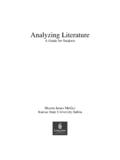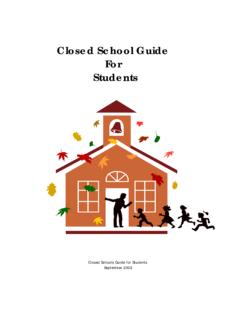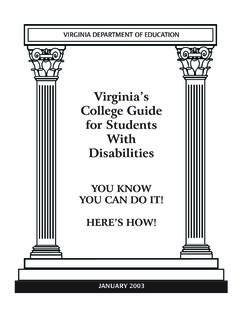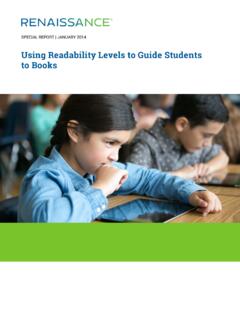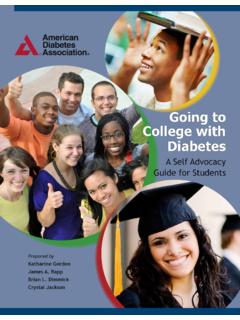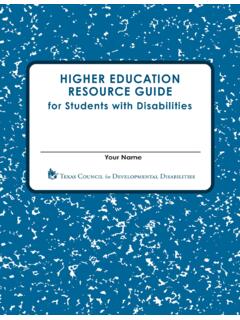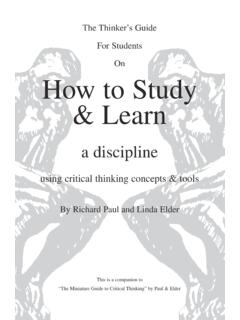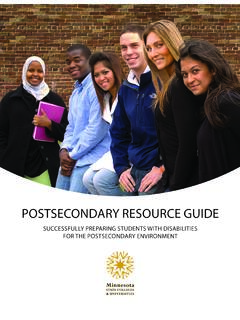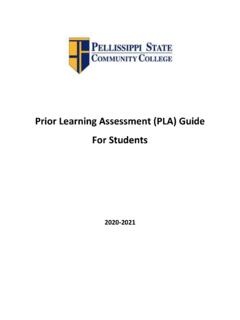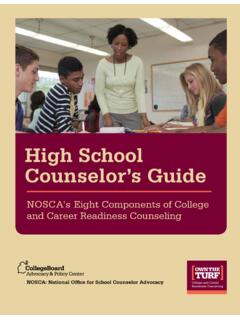Transcription of A Brief Guide for teachers and administrators
1 Guide FOR teachers Mathematics Assessment Project CLASSROOM CHALLENGES Formative Assessment Lessons A Brief Guide for teachers and administrators Mathematics Assessment Resource Service University of Nottingham & UC Berkeley For more details, visit: 2013-2015 MARS, Shell Center, University of Nottingham May be reproduced, unmodified, for non-commercial purposes under the Creative Commons license detailed at - all other rights reserved Mathematics Assessment Project UNIVERSITY OF NOTTINGHAM & UC BERKELEY The Classroom Challenges Formative Assessment Lessons discussed in this Guide are available, free-of-charge for noncommercial use, from the project website.
2 The website also offers more details about the project, summative assessment tasks, prototype professional development materials and details of the alignment of these materials with the Common Core State Standards. 20th October 2013 Please send comments to 2013-2015 MARS, Shell Center, University of Nottingham. This document may be distributed, unmodified, under the Creative Commons Attribution, Non-commercial, No Derivatives License detailed at All other rights reserved. Please send any enquiries about commercial use or derived works to Classroom Challenges Page 1 A Brief Guide Contents Contents 1 Summary introduction 2 The Structure of the Classroom Challenges 3 Top Ten Reasons for Using the Classroom Challenges 6 Implementation 5 Lesson preparation 8 Classroom culture: student and teacher roles 9 Design principles and design features 11 Lesson Genres and the Mathematical Practices 13 WHAT IS THE PURPOSE OF THIS BOOKLET?
3 This booklet is designed to help classroom teachers and district administrators understand what the Classroom Challenges are and how they can help put the Common Core State Standards for Mathematics into action, including the Standards for Mathematical Practice. It describes the structure and organization of Classroom Challenges (CCs), how they address the CCSS, how they work1, and how they function to stimulate and deepen students mathematical thinking. The booklet, along with the individual Classroom Challenges lesson and teacher s guides, describe a pedagogical stance and a role for the teacher that aligns with the research on formative assessment.
4 Some teachers will likely find it different from their current practice. The booklet also includes the reactions of teachers who have used these lessons and their perspective based on interviews by an independent evaluation team with 12 middle and high school teachers . Each of the teachers interviewed piloted several Classroom Challenges in their classrooms. They come for three different states: California, Michigan and Rhode Island. 1 The lessons have been developed, from research-based draft designs to the final products, through an iterative process of piloting and refinement.
5 Reports on each pilot lesson are gathered from a trained observer, the teacher and the students including samples of student work. This feedback covers how well (or not) the lessons are working as envisaged. These reports Guide the revisions by the design team. Classroom Challenges Page 2 A Brief Guide Summary introduction WHAT IS A CLASSROOM CHALLENGE? A Classroom Challenge (CC) is a classroom-ready lesson that supports formative assessment. The CCs help teachers assess and improve students understanding of mathematical concepts and skills and their ability to use the mathematical practices described in the Common Core State Standards.
6 And, they are available free of charge at: There are two types of CCs: Concept development lessons that are meant to first reveal students prior knowledge, then develop students understanding of important mathematical ideas, connecting concepts to other mathematical knowledge. Problem solving lessons are meant to assess, then develop, students ability to apply their mathematical knowledge and reasoning in flexibly ways to non-routine, unstructured problems within mathematics and with real world applications. WHY USE CLASSROOM CHALLENGES? Research has shown that formative assessment, as embodied in the Classroom Challenges, is a powerful way to improve student learning and performance.
7 This approach first allows students to demonstrate their prior understandings and abilities in employing the mathematical practices, and then involves students in resolving their own difficulties and misconceptions through structured discussion. This results in more secure long-term learning, reducing the need for re-teaching that otherwise takes so much classroom time. WHAT ARE THE KEY DIFFERENCES BETWEEN FORMATIVE ASSESSMENT TEACHING AND REGULAR TEACHING? Formative assessment involves a change in classroom culture with teachers and students moving into rather different roles from those common in most classrooms: students take more responsibility for, their own work.
8 students engage in productive struggle with rich challenging tasks. Resolution comes only gradually through interactions and discussion in the lesson as students gain new facets of connected understanding. students study fewer tasks, but in greater depth. They are asked to draft solutions, compare their approaches to others and redraft their ideas as a result of their discussions. The teachers role is to prompt students to reflect and reason through their ideas. teacher questioning is central to support students thinking and depth of knowledge, and student growth. The teacher s role is not to provide answers and solutions.
9 One way to shift practice, as described in the CCSS, is to begin by inserting occasional rich lessons such as Classroom Challenges. These lessons are designed to support these shifts with specific guides for each lesson. teachers have found the Lesson Guides helpful and supportive in their efforts to implement formative assessment lessons and the CCSS mathematical practices and to expand their pedagogy and practice. Classroom Challenges Page 3 A Brief Guide WHEN SHOULD I USE CLASSROOM CHALLENGES? Classroom Challenges give powerful support for learning at various stages: Concept development CCs have been found to be helpful when used about two-thirds of the way into a unit of study, as they help teachers and students evaluate their learning, yet leave time to work on concepts that students are still struggling with, as well as time to build on the lesson s idea during the rest of the unit.
10 teachers have also used them at the start of a new school year or unit, when they are concerned or need more knowledge of their students understanding of an important concept taught in an earlier grade. Using a formative assessment lesson, focused on that concept, can help determine students level of understanding and identify gaps, allowing a teacher to be more focused in their instruction at the start of the new unit. Problem solving CCs are to be used every month or two throughout the year. They offer teachers the opportunity to develop students proficiencies in the mathematical practices and concepts through deepening, consolidating concepts and building new connections.
